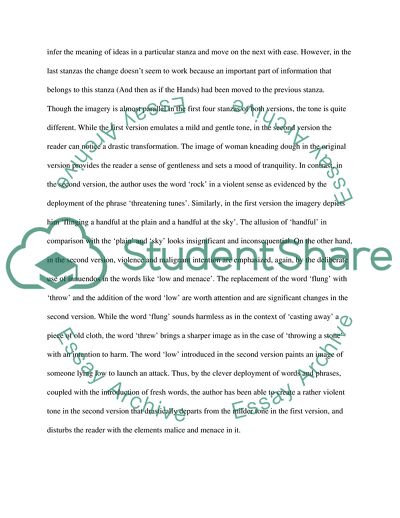
- Home
- Free Samples
- Premium Essays
- Editing Services
- Extra Tools
- Essay Writing Help
- About Us
- Studentshare
- Subjects
- Miscellaneous
- Essay On Poem reading
On Poem reading - Essay Example

- Subject: Miscellaneous
- Type: Essay
- Level: Masters
- Pages: 4 (1000 words)
- Downloads: 0
- Author: ziemecamron
Extract of sample "On Poem reading"
the second version, ‘The Wind Begun to Rock the Grass’ potentially differs from the first version, ‘The Wind Begun to Knead the Grass’, in terms of its emphasis on the element of violence in the wind. The revised version also drastically departs from the original in organization, syntax, vocabulary and punctuation. While the first version does not give distinct pauses at the points of transition in thoughts, the stanza form in the second version will be acceptable to the modern reader as it has a better visual appeal.
In the original, all lines except for the sixteenth are tinged with hyphens, and noticeably the poem ends not with a period but a hyphen. Perhaps it is a cue for the continuation of the play of wind as an integral part of nature and its power to wreak havoc in human life. In the second version, however, several lines are conspicuously devoid of hyphenation but the ending lines with hyphen appear to render seamless continuity to the thought flow. Unlike the first version, the second version has more white space in between stanzas preceded by periods except the last two stanzas where the author doesn’t use any periods.
The stanza form in the revised version also provides the readers the time to assimilate the ideas and ponder over them. This enables them to infer the meaning of ideas in a particular stanza and move on the next with ease. However, in the last stanzas the change doesn’t seem to work because an important part of information that belongs to this stanza (And then as if the Hands) had been moved to the previous stanza. Though the imagery is almost parallel in the first four stanzas of both versions, the tone is quite different.
While the first version emulates a mild and gentle tone, in the second version the reader can notice a drastic transformation. The image of woman kneading dough in the original version provides the reader a sense of gentleness and sets a mood of tranquility. In contrast, in the second version, the author
...Download file to see next pages Read More
- TERMS & CONDITIONS
- PRIVACY POLICY
- COOKIES POLICY